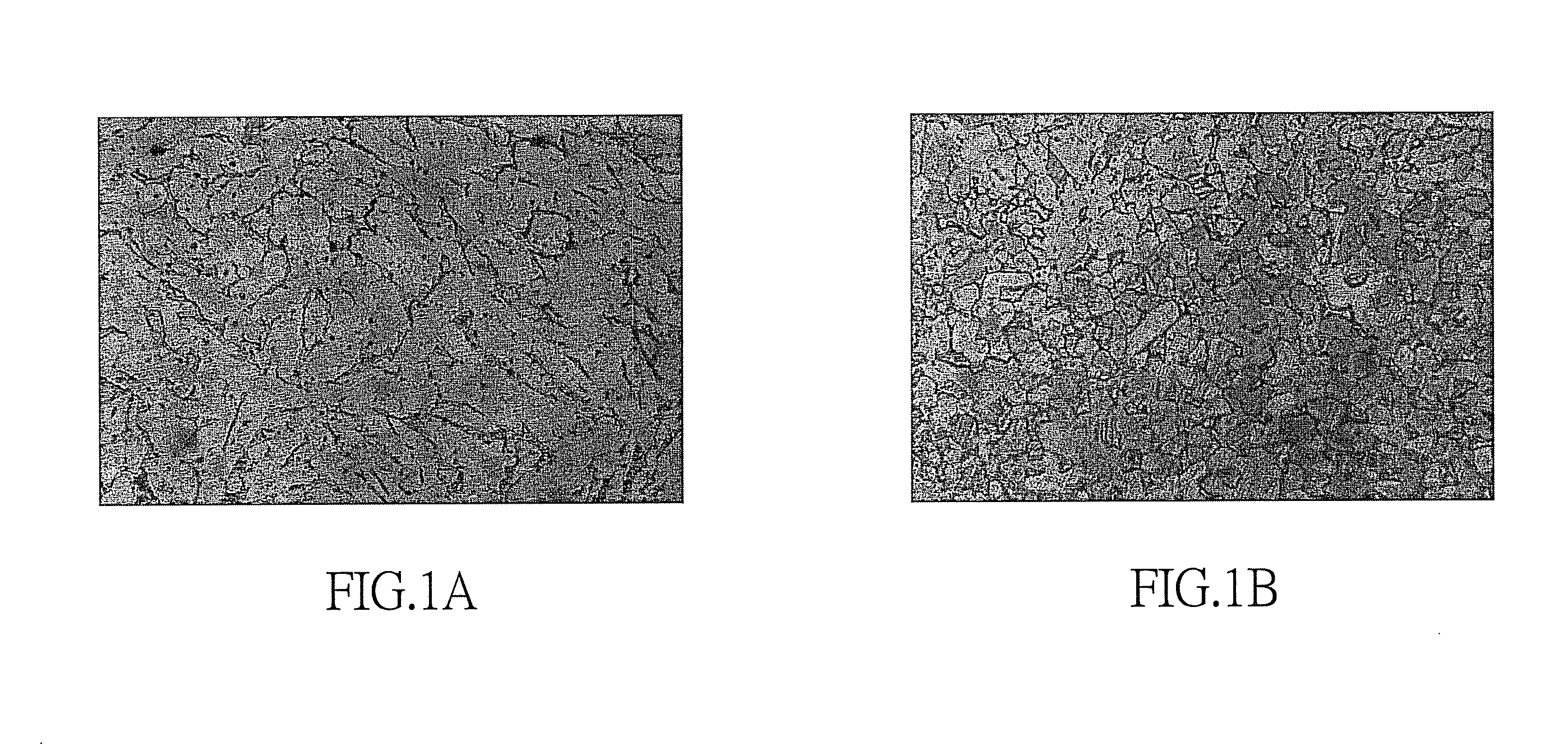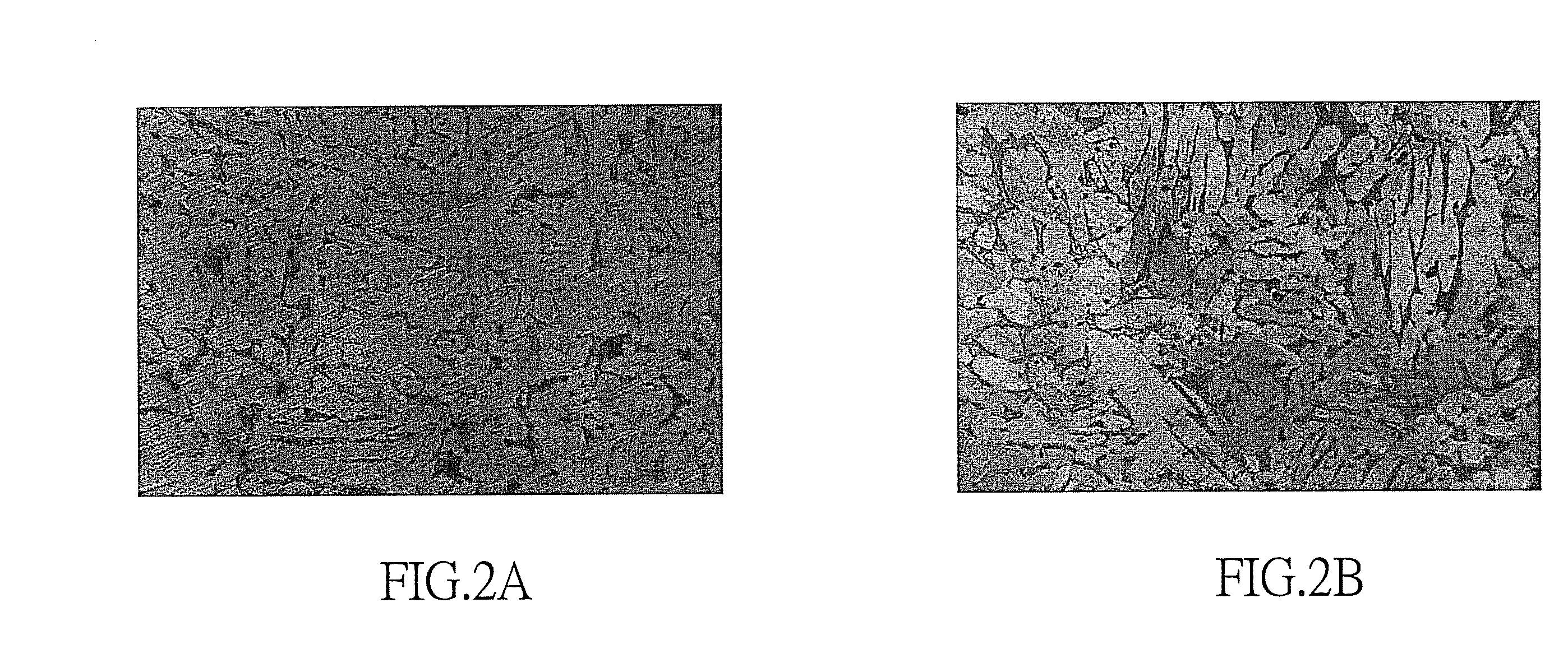Dezincification-resistant copper alloy and method for producing product comprising the same
a copper alloy and dezincification-resistant technology, applied in the field of dezincification-resistant low lead brass alloys, can solve the problems of alloy compositions, environmental factors, and high risk of dezincification, and achieve the effects of reducing the residual stress and defects in alloy grains, reducing the number of point defects, and reducing the residual stress and defects
Inactive Publication Date: 2011-03-17
GLOBE UNION INDAL
View PDF10 Cites 2 Cited by
- Summary
- Abstract
- Description
- Claims
- Application Information
AI Technical Summary
Benefits of technology
[0010]In the dezincification-resistant low-lead brass alloy of the present invention, the copper content ranges from 59.5 to 64 wt %. In a preferred embodiment, the copper content ranges from 62 to 64 wt %. The range of the copper content can provide good toughness, so that subsequent processing of the alloy material is facilitated.
[0029]By employing the method of the present invention, heat treatment, a holding temperature and cooling are used to process the casting product, so as to lower the toughness of the alloy material of the present invention and increase the plasticity and machinability thereof. Further, the residual stress of the alloy material is reduced, thereby lowering the stress corrosion. The dezincification resistance of the alloy material is also increased.
Problems solved by technology
If the zinc content of brass exceeds 20 wt %, corrosion (such as dezincification) is likely to occur.
For example, when a brass alloy article is employed in the environment, zinc present on the alloy surface is preferentially dissolved and copper contained in the alloy remains on the base metal, thereby causing corrosion in the form of porous, brittle copper.
It has been reported in literature that alloy compositions and environmental factors affect dezincification corrosion.
Because dezincification of brass severely damages the structures of brass alloys, the surface intensities of brass products produced from brass alloys are lowered such that porosity occurs on brass pipes.
This significantly lowers the lifetimes of the brass products, thereby causing application problems.
In particular, under the conditions of a marine climate, the lifespan of hot water products are directly affected.
However, there is also literature reporting that common brass products are not likely to meet the high standards set forth in AS 2345 (referring to Casting Technology, 2007, volume 9, pages 1272-1274).
However, as the awareness of environmental protection increases and the impacts of heavy metals on human health and issues like environmental pollution become major focuses, there is a tendency to restrict the usage of lead-containing alloys.
Method used
the structure of the environmentally friendly knitted fabric provided by the present invention; figure 2 Flow chart of the yarn wrapping machine for environmentally friendly knitted fabrics and storage devices; image 3 Is the parameter map of the yarn covering machine
View moreImage
Smart Image Click on the blue labels to locate them in the text.
Smart ImageViewing Examples
Examples
Experimental program
Comparison scheme
Effect test
example 1
[0055]
Cu: 63.3 wt %Bi: 0.375 wt %As: 0.122 wt %B: 10 ppmSn: 0.837 wt %Zr: 0.362 wt %Pb: 0.013 wt %Zn: in balance
example 2
[0056]
Cu: 63.06 wt %Bi: 0.335 wt %As: 0.107 wt %B: 8 ppmSn: 0.632 wt %Zr: 0.433 wt %Pb: 0.007 wt %Zn: in balance
example 3
[0057]
Cu: 62.6 wt %Bi: 0.413 wt %As: 0.138 wt %B: 12 ppmSn: 0.431 wt %Zr: 0.487 wt %Pb: 0.009 wt %Zn: in balance
the structure of the environmentally friendly knitted fabric provided by the present invention; figure 2 Flow chart of the yarn wrapping machine for environmentally friendly knitted fabrics and storage devices; image 3 Is the parameter map of the yarn covering machine
Login to View More PUM
| Property | Measurement | Unit |
|---|---|---|
| temperature | aaaaa | aaaaa |
| temperature | aaaaa | aaaaa |
| depth | aaaaa | aaaaa |
Login to View More
Abstract
A dezincification-resistant copper alloy and a method for producing a product comprising the same are proposed by the present invention. The dezincification-resistant alloy of the present invention comprises 59.5 to 64 wt % of copper (Cu); 0.1 to 0.5 wt % of bismuth (Bi); 0.08 to 0.16 wt % of arsenic (As); 5 to 15 ppm of boron (B); 0.3 to 1.5 wt % of tin (Sn); 0.1 to 0.7 wt % of zirconium (Zr); less than 0.05 wt % of lead (Pb); and zinc (Zn) in balance. The dezincification-resistant copper alloy of the present invention has excellent casting properties, good toughness and machinability, and can be corrosion-resistant. Thus, the alloy can reduce dezincification on the surfaces thereof.
Description
BACKGROUND OF THE INVENTION[0001]1. Field of the Invention[0002]The present invention relates to dezincification-resistant copper alloys methods for producing a product comprising the same, and more particularly, to a dezincification-resistant low lead brass alloy and a method for producing a product comprising the same.[0003]2. Description of Related Art[0004]Brass comprises copper and zinc, as major ingredients, usually at a ratio of about 7:3 or 6:4. If the zinc content of brass exceeds 20 wt %, corrosion (such as dezincification) is likely to occur. For example, when a brass alloy article is employed in the environment, zinc present on the alloy surface is preferentially dissolved and copper contained in the alloy remains on the base metal, thereby causing corrosion in the form of porous, brittle copper. Generally, if the zinc content is less than 15 wt %, dezincification is not likely to occur. However, as the zinc content increases, the sensitivity to dezincification is increa...
Claims
the structure of the environmentally friendly knitted fabric provided by the present invention; figure 2 Flow chart of the yarn wrapping machine for environmentally friendly knitted fabrics and storage devices; image 3 Is the parameter map of the yarn covering machine
Login to View More Application Information
Patent Timeline
 Login to View More
Login to View More Patent Type & Authority Applications(United States)
IPC IPC(8): C22F1/08C22C9/02B22D7/02
CPCB22D7/005C22F1/08C22C9/04
Inventor LO, WEN LINFANG, XIAO RONG
Owner GLOBE UNION INDAL
Features
- R&D
- Intellectual Property
- Life Sciences
- Materials
- Tech Scout
Why Patsnap Eureka
- Unparalleled Data Quality
- Higher Quality Content
- 60% Fewer Hallucinations
Social media
Patsnap Eureka Blog
Learn More Browse by: Latest US Patents, China's latest patents, Technical Efficacy Thesaurus, Application Domain, Technology Topic, Popular Technical Reports.
© 2025 PatSnap. All rights reserved.Legal|Privacy policy|Modern Slavery Act Transparency Statement|Sitemap|About US| Contact US: help@patsnap.com



